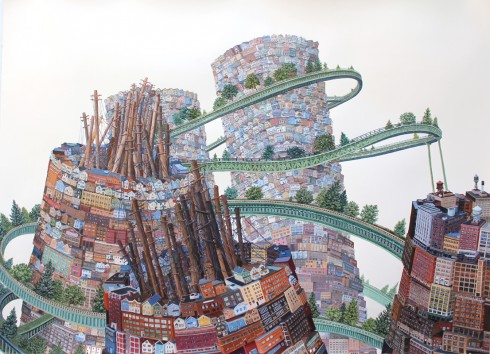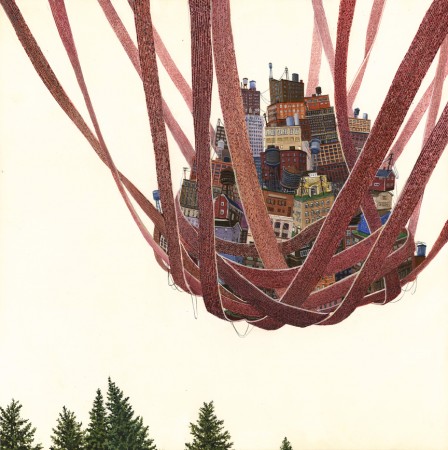Fantasy is a genre that is, in many ways, marginalized, cast aside as mere whimsy, or worse, as an invention used to amuse rather than probe. However, it is fantasy’s close proximity to what we deem to be real that camouflages the importance of such a genre: from early human exploration, to technological leaps, the fantastical has been the seed for every human advancement; and, upon blossoming, has become what we so comfortably refer to as “reality.” Amy Casey’s newest exhibition, Balancing New Growth, on display until January 5th at Foley Gallery, is an absurdist, yet poignant take on the construction of cities. In the coming decades, the way cities are created and re-imagined will not only directly reflect growing populations, but will rely more heavily on technology’s dictation as to how metropolises can better support the flow of information. This is why Casey’s exhibition, while extreme in its characterization, feels less like fantasy, and more like viable commentary.

Balancing New Growth, which may be an intentionally ironic misnomer, is adept at depicting the sometimes claustrophobic, entangled nature of modern cities. The piece Hitch denotes the fragility of urban life, as whole neighborhoods dangle by the most tenuous of strings. Of course, these “strings” most nearly resemble telephone wires, threads of communication that knot houses to one another. The connotation here being that these technological connections save individual domiciles from plummeting into the nothingness of isolation, an ignominious excommunication from urban life. Meanwhile, to the right of the image, a neighboring community appears, held together by a rubber band stretched so tight as to be bending some of the skyscrapers (a visual representation of the pressure born of such close living conditions).

These same rubber bands can be seen in Woven, this time separating the tight knit band of houses from the natural world in a setup eerily similar to a cradle, a secluded, self-sufficient biosphere protected from the dangers of the outdoors. The trees that just peak into the frame from the bottom-left are parodied by the telephone poles in Circulating Green, which rise out of the centers of monolithic structures of buildings akin to nuclear reactors. Information powers the contemporary city, a lifeblood of sorts. While it would be ludicrous to say Casey’s exhibition is a realistic representation of future urban development, Balancing New Growth humorously comments upon the dawning of a new age in human discovery: for thousands of years exploration has been about movement out and away to new lands/territories; in the near future, our technological advancements will compel us to re-imagine the way we live amongst one another. Casey captures the farcical side of this shift in thinking.
Text by Paul Longo

